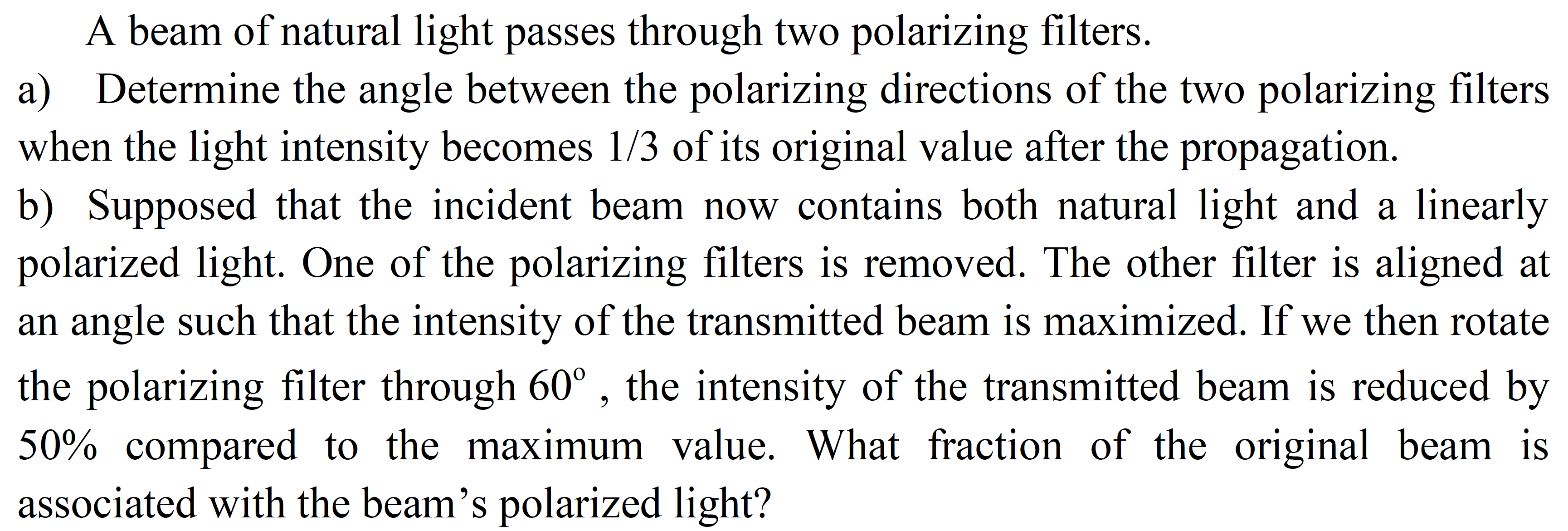
College Physics
11th Edition
ISBN: 9781305952300
Author: Raymond A. Serway, Chris Vuille
Publisher: Cengage Learning
expand_more
expand_more
format_list_bulleted
Question

Transcribed Image Text:A beam of natural light passes through two polarizing filters.
a)
Determine the angle between the polarizing directions of the two polarizing filters
when the light intensity becomes 1/3 of its original value after the propagation.
b) Supposed that the incident beam now contains both natural light and a linearly
polarized light. One of the polarizing filters is removed. The other filter is aligned at
an angle such that the intensity of the transmitted beam is maximized. If we then rotate
the polarizing filter through 60° , the intensity of the transmitted beam is reduced by
50% compared to the maximum value. What fraction of the original beam is
associated with the beam's polarized light?
Expert Solution
This question has been solved!
Explore an expertly crafted, step-by-step solution for a thorough understanding of key concepts.
Step by stepSolved in 2 steps with 2 images

Knowledge Booster
Similar questions
- Unpolarized light of intensity20.0 W/cm2 is incident on two polarizing filter. The axis of the first filter is at an angle of 25 degrees counterclockwise from the vertical and the axis of the second filter is 62 degrees counterclockwise from the vertical. a.) What is the intensity of the light after it has passed through the second polarizer?arrow_forwardSuppose a polarizing filter reduces the intensity of polarized light to 65 % of its original value. (a) By how much is the magnetic field of the electromagnetic radiation reduced? Give your answer in terms of a ratio of the magnetic field of the polarized light Bp to the incident magnetic field B0.arrow_forwardUnpolarized light with intensity 200 W/m^2 travelling to the right, is incident on the left-most polarizer and goes through all three polarizers of the figure. The dotted lines are the axes of polarization of each polarizer a) What is the intensity of light leaving the left-most polarizer? b) If the middle polarizer has an axis of polarization θ2 = 75º clockwise from the vertical (viewed in the direction the light is travelling), what is the intensity of light leaving the middle polarizer? c) If the right-most polarizer has an axis of polarization θ1 = 25º counterclockwise from the vertical (viewed in the direction the light is travelling), what is the intensity of light leaving the right-most polarizer?arrow_forward
- Physics Polarization: Write down the equations of an unpolarized E field before it hits a linear polarizer that is polarized in the x-direction. What are the E field equations after the linear polarization? I'm having extreme difficulty on this problem, need some guidance.arrow_forwardAn unpolarized light has maximum magnetic field value of 0.830 nanoTesla. a) What is the maximum electric field strength of light? b) What is the intensity of the light after passing through two linear polarizing filters. One polarizer whose axis is 20 degrees from vertical and the other polarizer whose axis is 15 degrees from horizontal.arrow_forwardExperiments show that the ground spider Drassodes cupreus uses one of its several pairs of eyes as a polarization detector In fact, the two eyes in this pair have polarization directions that are at right angles to one another Suppose linearly polarized light with an intensity of 775 W/m² shines from the sky onto the spider and that the intensity transmitted by one of the polarizing eyes is 774 W/m². For this eye, what is the angle between the polarization direction of the eye and the polarization direction of the incident light?arrow_forward
- Polarized light passes through two rotated filters from left to right, as shown. At the point A, its intensity is Io. The polarization axis of the first polarizer makes an angle 01= 52.6° with the direction of polarization the incoming light. The polarization axis of the second polarizer makes an angle 02= 59.6° degrees with the polarization axis of the first polarizer. E Polarized В light The intensity of light at the point C is:arrow_forwardWe want to rotate the direction of polarization of a beam of polarized light through 90° by sending the beam through one or more polarizing sheets. (a) What is the minimum number of sheets required? (b) What is the minimum number of sheets required if the transmitted intensity is to be more than 83% of the original intensity?arrow_forward
arrow_back_ios
arrow_forward_ios
Recommended textbooks for you
 College PhysicsPhysicsISBN:9781305952300Author:Raymond A. Serway, Chris VuillePublisher:Cengage Learning
College PhysicsPhysicsISBN:9781305952300Author:Raymond A. Serway, Chris VuillePublisher:Cengage Learning University Physics (14th Edition)PhysicsISBN:9780133969290Author:Hugh D. Young, Roger A. FreedmanPublisher:PEARSON
University Physics (14th Edition)PhysicsISBN:9780133969290Author:Hugh D. Young, Roger A. FreedmanPublisher:PEARSON Introduction To Quantum MechanicsPhysicsISBN:9781107189638Author:Griffiths, David J., Schroeter, Darrell F.Publisher:Cambridge University Press
Introduction To Quantum MechanicsPhysicsISBN:9781107189638Author:Griffiths, David J., Schroeter, Darrell F.Publisher:Cambridge University Press Physics for Scientists and EngineersPhysicsISBN:9781337553278Author:Raymond A. Serway, John W. JewettPublisher:Cengage Learning
Physics for Scientists and EngineersPhysicsISBN:9781337553278Author:Raymond A. Serway, John W. JewettPublisher:Cengage Learning Lecture- Tutorials for Introductory AstronomyPhysicsISBN:9780321820464Author:Edward E. Prather, Tim P. Slater, Jeff P. Adams, Gina BrissendenPublisher:Addison-Wesley
Lecture- Tutorials for Introductory AstronomyPhysicsISBN:9780321820464Author:Edward E. Prather, Tim P. Slater, Jeff P. Adams, Gina BrissendenPublisher:Addison-Wesley College Physics: A Strategic Approach (4th Editio...PhysicsISBN:9780134609034Author:Randall D. Knight (Professor Emeritus), Brian Jones, Stuart FieldPublisher:PEARSON
College Physics: A Strategic Approach (4th Editio...PhysicsISBN:9780134609034Author:Randall D. Knight (Professor Emeritus), Brian Jones, Stuart FieldPublisher:PEARSON

College Physics
Physics
ISBN:9781305952300
Author:Raymond A. Serway, Chris Vuille
Publisher:Cengage Learning

University Physics (14th Edition)
Physics
ISBN:9780133969290
Author:Hugh D. Young, Roger A. Freedman
Publisher:PEARSON

Introduction To Quantum Mechanics
Physics
ISBN:9781107189638
Author:Griffiths, David J., Schroeter, Darrell F.
Publisher:Cambridge University Press

Physics for Scientists and Engineers
Physics
ISBN:9781337553278
Author:Raymond A. Serway, John W. Jewett
Publisher:Cengage Learning

Lecture- Tutorials for Introductory Astronomy
Physics
ISBN:9780321820464
Author:Edward E. Prather, Tim P. Slater, Jeff P. Adams, Gina Brissenden
Publisher:Addison-Wesley

College Physics: A Strategic Approach (4th Editio...
Physics
ISBN:9780134609034
Author:Randall D. Knight (Professor Emeritus), Brian Jones, Stuart Field
Publisher:PEARSON